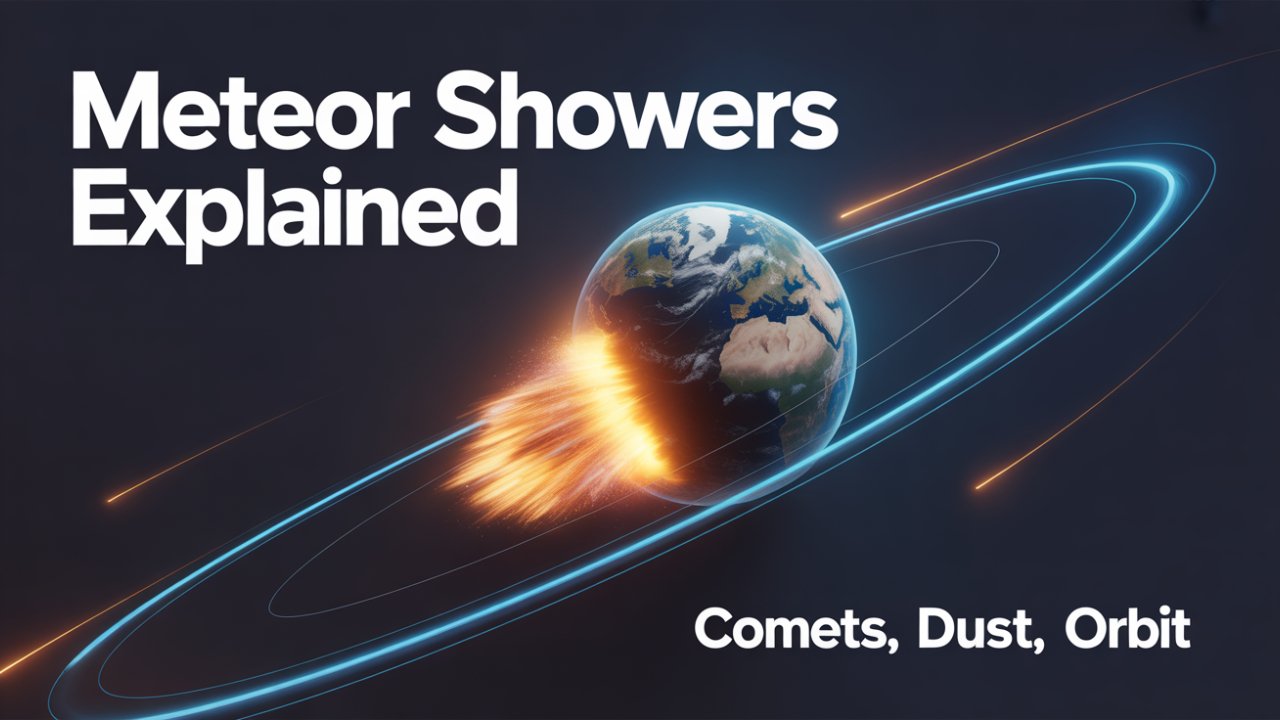Every year, like clockwork, the heavens put on a spectacular show. The Perseids in August, the Geminids in December… it’s a celestial event with the punctuality of a Swiss watch. But have you ever stopped to wonder why? Why do these cosmic fireworks show up at the same time every year?
The answer is a fascinating story about our planet’s annual journey through ancient dust trails, left behind by celestial wanderers. It’s a story of cosmic litter, orbital mechanics, and those beautiful, fleeting moments when our world connects with the ghosts of comets. The solution to this mystery isn’t just a simple fact; it’s a journey that reveals the elegant clockwork of our entire solar system.
Most of us have done it. You’re staring up into the velvet black of a clear night sky and… zip. A sudden, silent streak of light dashes across the stars. We call it a “shooting star,” make a wish, and feel a momentary connection to the universe.
But the first step in unraveling our mystery is to debunk that romantic name. What we’re seeing isn’t a star at all. Stars are colossal, distant suns. A star actually falling from the sky would be an extinction-level event. What we’re really seeing is something much smaller, much closer, and far more personal to our own solar system.
To really get what’s going on, we need to get our terms straight. It all starts with a meteoroid. A meteoroid is simply a piece of rock or dust traveling through space. These can be anything from a tiny grain of sand to a small boulder. They’re the silent, invisible debris of the solar system.
The magic happens when a meteoroid’s path crosses ours. As this piece of space rock plummets into Earth’s atmosphere, it gets a new name: a meteor. The streak of light we call a shooting star is the visible proof of this dramatic entrance. Traveling at incredible speeds anywhere from 25,000 to 160,000 miles per hour the meteoroid compresses the air in front of it. This generates immense heat, causing the space rock to glow and burn up in a process called ablation. What we see is both the burning rock and the glowing trail of ionized air it leaves behind a brilliant, momentary plasma trail happening about 60 miles above our heads.
It’s amazing to think that most of these breathtaking streaks are caused by particles no bigger than a pebble. A tiny speck of dust can create a flash of light visible from the ground, all thanks to the incredible speeds involved.
But what if a piece survives its fiery plunge? If it’s big enough to not burn up completely and it actually hits the ground, it gets its final name: a meteorite. These are the celestial messengers we can actually hold in our hands, tangible pieces of other worlds that give us clues about the history of our solar system.
So, to recap: a meteoroid is the rock in space, a meteor is the light in the sky, and a meteorite is the rock on the ground. For the rest of our journey today, we’re focused on the meteor that beautiful flash of light and why they sometimes come in showers.
So, if meteor showers happen when Earth hits a swarm of meteoroids, the next question is obvious: where does all this stuff come from? The culprits are two of the most fascinating objects in our solar system: comets and, in some cases, asteroids.
Let’s start with the main suspect: comets. For centuries, people saw comets as mysterious omens with their ghostly, glowing tails. We now know they are basically giant, dirty snowballs primordial leftovers from the formation of the solar system. A comet is a mix of ice, frozen gases, rock, and dust.
For most of its life, a comet drifts through the deep freeze of the outer solar system. But its orbit is often a huge, looping path that periodically brings it close to the Sun. And that’s when the show starts. As a comet gets closer to the Sun, the heat causes its ices to turn directly into gas a process called sublimation. This outflow of gas and dust creates a glowing atmosphere around the comet’s core, which we call a coma.
As the comet gets even closer, the Sun’s solar wind and the pressure of sunlight itself push this gas and dust away, forming its magnificent tails. There’s a gas tail that points directly away from the Sun, and the one that interests us most: the dust tail. This tail is made of the heavier bits of rock and dust that were trapped in the ice, and it gets left behind, spreading out along the comet’s orbital path.
Think of a comet as a messy truck on a cosmic highway. Every time it loops around the Sun, it sheds a fresh layer of dust and rock, leaving a trail of debris. Over thousands of years, this creates a vast, ghostly tube of meteoroids that continues to orbit the Sun. This is the meteoroid stream.
The most famous example is Comet 109P/Swift-Tuttle. Discovered in 1862, this comet is a beast, with a nucleus about 16 miles across. It travels on a 133-year orbit, and every time it passes through the inner solar system, it replenishes the cloud of debris that gives us the Perseid meteor shower. And we know it’s long-lasting; records of the Perseids have been kept for nearly 2,000 years.
But comets aren’t the only ones making a mess. In a fun twist, some of our best meteor showers come from asteroids. The best example is the Geminids, which light up our skies every December. For a long time, the origin of the Geminids was a total mystery. Then, in 1983, a NASA satellite discovered a strange asteroid named 3200 Phaethon, and its orbit was a perfect match for the Geminid meteoroid stream.
This was puzzling. Asteroids are rock and metal; they shouldn’t create debris trails like icy comets. So how does Phaethon do it? The leading theory is that it’s a “rock comet.” Its orbit takes it incredibly close to the Sun, and the intense heat might be causing its surface to fracture and crumble, releasing streams of dust. And the stuff Phaethon sheds is different, too. It’s denser than comet dust, which may be why Geminid meteors are often so bright and intensely colored.
Whether it’s the icy spray from a majestic comet or the sun-baked crumbling of a weird asteroid, the result is the same: a river of space dust, laid down in a predictable orbit around our Sun.
We’ve figured out the what the flash of light and the who the comets and asteroids. Now we get to the heart of the mystery: the why. Why do these showers return on the same dates every single year? The answer is a beautiful and elegant intersection of predictable orbits.
Remember those meteoroid streams? They aren’t just a puff of dust; they’re a continuous trail of particles stretching along the parent body’s entire orbit. You can picture it as a gigantic, invisible river of dust flowing through space, permanently marking the path around the Sun. The location of this river is remarkably consistent.
Now, think about our own planet. Earth also follows a predictable path: its orbit around the Sun, which we complete every 365 and a quarter days. Year after year, we travel along almost the exact same route.
The secret to the timing is a simple geometric truth: our annual path intersects with these debris-filled rivers. It’s not that the debris cloud is moving to find us; it’s that we, on our journey, are plowing right through it.
This is the “aha!” moment. The timing of a meteor shower is simply the date on the calendar when Earth arrives at the exact point in its orbit where it crosses a dust trail.
Imagine you’re driving a car on a massive, circular racetrack that’s Earth’s orbit. At one specific point on this track, a swarm of bugs is always hovering over the road. That’s the meteoroid stream. Every single time you drive your car around the track, you will drive through that same swarm of bugs at the exact same point in your lap. The result? A sudden flurry of bugs on your windshield. You could set your watch by it.
This is precisely what happens with meteor showers. The Perseids happen in mid-August every year because that’s when Earth’s orbit intersects the sprawling debris trail left by Comet Swift-Tuttle. We hit that cometary dust cloud on schedule, every single year.
The same goes for all the other major showers. The Geminids peak around December 13th and 14th because that’s when our orbit crosses the rocky debris from the asteroid 3200 Phaethon. The Orionids in late October? That’s us passing through the trail of the most famous comet of all, Halley’s Comet. In fact, we cross Halley’s path twice, which is why it also gives us the Eta Aquariid shower in May.
When you watch a meteor shower, you are witnessing tangible proof that our planet is hurtling through space. It’s a moment where the invisible architecture of the solar system becomes stunningly visible. The punctuality isn’t magic; it’s geometry on a cosmic scale.
Knowing the orbital mechanics is key, but it doesn’t quite capture the experience of watching from the ground. Two more ideas really enrich the show: the radiant point and why a shower’s intensity changes.
First, the radiant point. If you watch a meteor shower for a while, you’ll notice something cool. Even though meteors can appear anywhere in the sky, if you trace their paths backward, they all seem to come from a single spot. This is the radiant. It’s a trick of perspective, just like how parallel railroad tracks seem to meet at a point on the horizon.
The meteoroids in a stream are all traveling on parallel paths. When Earth hits them, it’s like driving into a snowstorm the flakes all seem to fly at you from a single point ahead. This radiant is how showers get their names. The Perseids appear to radiate from the constellation Perseus. The Geminids from Gemini. The Leonids from Leo. So, the name tells you where to look.
The second piece of the puzzle is the shower’s intensity. Meteor showers are punctual, but they aren’t all equally spectacular every year. The number of meteors can change dramatically. Why?
Well, the main reason is that the stream of debris isn’t perfectly even. It has clumps and sparse areas, like a river with deep channels and shallow spots. The kind of show we get depends on which part of the stream Earth passes through. If we hit a dense clump, we get a great show. If we pass through a thin patch, it’s more subdued.
Sometimes, this leads to a meteor storm. This is a rare and incredible event where Earth passes through a very fresh, dense ribbon of debris. Instead of 100 meteors an hour, you might see thousands. The Leonid shower is famous for this, producing legendary storms where meteors fell like rain.
Another factor is gravity. Over centuries, the immense gravity of planets, especially Jupiter, can gently tug on the stream, shifting its orbit. This can cause a weak shower to become stronger over time, or a strong one to fade. The Geminids, for example, weren’t really a thing before the mid-1800s but have gotten better and better, suggesting Jupiter’s gravity nudged the stream into a more direct path with Earth.
So while the timing is fixed, the quality of the show is always a bit of a surprise. You know when to look, but you never know exactly what you’re going to get.
Now that you know the whole cosmic story, the final step is to experience it for yourself. Watching a meteor shower doesn’t take any fancy gear, but a little prep can make all the difference.
First, timing is everything. The best time to watch is almost always between midnight and dawn. In the evening, you’re on the trailing side of the Earth. But after midnight, your spot on the planet has rotated to face forward in the direction of our orbit. You’re on the front windshield, so to speak, heading straight into the meteoroid stream.
Next: location, location, location. Your biggest enemy is light pollution. To get the best view, you have to get away from city lights. Find a dark spot a park, a rural road, anywhere with a wide-open view of the sky. The darker the sky, the more you’ll see.
As for equipment? The best tools are your own two eyes. You can leave the binoculars and telescope at home. They actually hurt your chances because they limit your field of view, and you want to see as much sky as possible.
Then, get comfortable. You’re going to be outside for a while, so a reclining chair or a thick blanket is a must. Dress in warm layers, even on a summer night. Bring snacks, a warm drink, and most importantly, bring patience. Your eyes need about 20 minutes to fully adapt to the dark, so put your phone away. Its bright screen will ruin your night vision.
Finally, check on the one object that can make or break the show: the Moon. A bright moon can wash out the sky just like city lights. The best showers are the ones that peak near a new moon. If there is a bright moon, all is not lost. Just try to keep it out of your direct line of sight.
With these tips, you’re ready. You’re ready to lay back, look up, and watch the cosmic clockwork in action.
If this journey through the cosmos blew your mind, make sure you subscribe and hit that notification bell. We dive into the biggest questions the universe has to offer, from black holes to dark matter.
And I have a question for you: What’s the most incredible thing you’ve ever seen in the night sky? A meteor shower? The Milky Way? Tell us your story in the comments below. I’d love to read about your own connection to the cosmos.
So, why do meteor showers happen at the same time every year? It’s not a coincidence; it’s a consequence of cosmic architecture. It’s the story of comets and asteroids shedding dust and debris as they orbit the Sun, creating vast, invisible rivers in space. And it’s the story of our own planet, reliably crossing those ancient streams at the same time, year after year.
The result is a celestial appointment, a light show connecting us to the deep history of our solar system. The next time you’re outside on a clear night and see a meteor streak across the sky, you’ll know you’re not just seeing a “shooting star.” You’re witnessing a tiny piece of a comet, born of ice and fire, ending its cosmic journey in a final, brilliant flash. You’re seeing the clockwork of the cosmos. All you have to do is look up.





